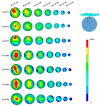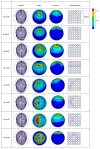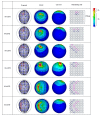Comprehensive Survey on Improved Focality and Penetration Depth of Transcranial Magnetic Stimulation Employing Multi-Coil Arrays
- PMID: 29135963
- PMCID: PMC5708027
- DOI: 10.3390/ijerph14111388
Comprehensive Survey on Improved Focality and Penetration Depth of Transcranial Magnetic Stimulation Employing Multi-Coil Arrays
Abstract
Multi-coil arrays applied in transcranial magnetic stimulation (TMS) are proposed to accurately stimulate brain tissues and modulate neural activities by an induced electric field (EF). Composed of numerous independently driven coils, a multi-coil array has alternative energizing strategies to evoke EFs targeting at different cerebral regions. To improve the locating resolution and the stimulating focality, we need to fully understand the variation properties of induced EFs and the quantitative control method of the spatial arrangement of activating coils, both of which unfortunately are still unclear. In this paper, a comprehensive analysis of EF properties was performed based on multi-coil arrays. Four types of planar multi-coil arrays were used to study the relationship between the spatial distribution of EFs and the structure of stimuli coils. By changing coil-driven strategies in a basic 16-coil array, we find that an EF induced by compactly distributed coils decays faster than that induced by dispersedly distributed coils, but the former has an advantage over the latter in terms of the activated brain volume. Simulation results also indicate that the attenuation rate of an EF induced by the 36-coil dense array is 3 times and 1.5 times greater than those induced by the 9-coil array and the 16-coil array, respectively. The EF evoked by the 36-coil dispense array has the slowest decay rate. This result demonstrates that larger multi-coil arrays, compared to smaller ones, activate deeper brain tissues at the expense of decreased focality. A further study on activating a specific field of a prescribed shape and size was conducted based on EF variation. Accurate target location was achieved with a 64-coil array 18 mm in diameter. A comparison between the figure-8 coil, the planar array, and the cap-formed array was made and demonstrates an improvement of multi-coil configurations in the penetration depth and the focality. These findings suggest that there is a tradeoff between attenuation rate and focality in the application of multi-coil arrays. Coil-energizing strategies and array dimensions should be based on an adequate evaluation of these two important demands and the topological structure of target tissues.
Keywords: electric field distribution; multi-coil array; target location; transcranial magnetic stimulation.
Conflict of interest statement
The authors declare no conflict of interest.
Figures













Similar articles
-
Electric field depth-focality tradeoff in transcranial magnetic stimulation: simulation comparison of 50 coil designs.Brain Stimul. 2013 Jan;6(1):1-13. doi: 10.1016/j.brs.2012.02.005. Epub 2012 Mar 21. Brain Stimul. 2013. PMID: 22483681 Free PMC article.
-
Design of transcranial magnetic stimulation coils with optimal trade-off between depth, focality, and energy.J Neural Eng. 2018 Aug;15(4):046033. doi: 10.1088/1741-2552/aac967. Epub 2018 Jun 1. J Neural Eng. 2018. PMID: 29855433 Free PMC article.
-
Coil design considerations for deep transcranial magnetic stimulation.Clin Neurophysiol. 2014 Jun;125(6):1202-12. doi: 10.1016/j.clinph.2013.11.038. Epub 2013 Dec 22. Clin Neurophysiol. 2014. PMID: 24411523 Free PMC article.
-
Application of transcranial magnetic stimulation for major depression: Coil design and neuroanatomical variability considerations.Eur Neuropsychopharmacol. 2021 Apr;45:73-88. doi: 10.1016/j.euroneuro.2019.06.009. Epub 2019 Jul 5. Eur Neuropsychopharmacol. 2021. PMID: 31285123 Review.
-
Figure-Eight Coils for Magnetic Stimulation: From Focal Stimulation to Deep Stimulation.Front Hum Neurosci. 2021 Dec 16;15:805971. doi: 10.3389/fnhum.2021.805971. eCollection 2021. Front Hum Neurosci. 2021. PMID: 34975440 Free PMC article. Review.
Cited by
-
Biomedical Applications of Electromagnetic Detection: A Brief Review.Biosensors (Basel). 2021 Jul 7;11(7):225. doi: 10.3390/bios11070225. Biosensors (Basel). 2021. PMID: 34356696 Free PMC article. Review.
-
Effects of sonication parameters on transcranial focused ultrasound brain stimulation in an ovine model.PLoS One. 2019 Oct 24;14(10):e0224311. doi: 10.1371/journal.pone.0224311. eCollection 2019. PLoS One. 2019. PMID: 31648261 Free PMC article.
-
Multisite non-invasive brain stimulation in Parkinson's disease: A scoping review.NeuroRehabilitation. 2021;49(4):515-531. doi: 10.3233/NRE-210190. NeuroRehabilitation. 2021. PMID: 34776426 Free PMC article.
-
Microfabrication Technologies for Nanoinvasive and High-Resolution Magnetic Neuromodulation.Adv Sci (Weinh). 2024 Dec;11(46):e2404254. doi: 10.1002/advs.202404254. Epub 2024 Oct 24. Adv Sci (Weinh). 2024. PMID: 39445520 Free PMC article. Review.
References
-
- Roth Y., Padberg F., Zangen A. Transcranial magnetic stimulation of deep brain regions: Principles and methods. Adv. Biol. Psychiatry. 2007;23:204–225.
-
- George M.S., Aston-Jones G. Noninvasive techniques for probing neurocircuitry and treating illness: Vagus nerve stimulation (VNS), transcranial magnetic stimulation (TMS) and transcranial direct current stimulation (tDCS) Neuropsychopharmacology. 2010;35:301–316. doi: 10.1038/npp.2009.87. - DOI - PMC - PubMed
-
- Rastogi P., Lee E.G., Hadimani R.L., Jiles D.C. Transcranial Magnetic Stimulation-coil design with improved focality. AIP Adv. 2016;7:56701–56705. doi: 10.1063/1.4973604. - DOI
-
- Im C.H., Lee C. Precise Estimation of Brain Electrical Sources Using Anatomically Constrained Area Source (ACAS) Localization. IEEE. Trans. Magn. 2007;42:1713–1716. doi: 10.1109/TMAG.2006.892286. - DOI
MeSH terms
LinkOut - more resources
Full Text Sources
Other Literature Sources
Miscellaneous

